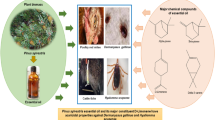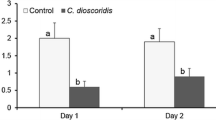Abstract
In cattle, Hyalomma scupense serves as an important vector of several pathogens resulting in diseases, subsequently affecting the agricultural field as well as the economy. Resistance to chemical acaricides has become widespread affirming the need for new drugs to tick control. The goal of this study was to investigate the acaricidal, repellent activities as well as the putative mode of action of two essential oils (EOs) from Melaleuca alternifolia (Tea tree) and Chamaemelum nobile (Roman chamomile) on Hyalomma scupense. The chemical composition of EOs was also evaluated. Different concentrations of EOs were tested in vitro for their acaricidal property on adults and larvae of H. scupense using adult immersion test (AIT) and larval packet test (LPT). Additionally, using Ellman’s spectrophotometric method, the anticholinesterase (AChE) inhibition activity of M. alternifolia and C. nobile EOs was assessed in order to understand their putative mode of action. The main compounds of C. nobile were α-Bisabolene (22.20%) and (E)-β-Famesene (20.41%). The major components in the analyzed M. alternifolia were Terpinen-4-ol (36.32%) and γ-Terpinene (13.69%). Adulticidal and larvicidal assays demonstrated a promising efficacy of the essential oils against tick H. scupense. The lethal concentration (LC50) values obtained for M. alternifolia and C. nobile oils were 0.84 and 0.96 mg/mL in the AIT and 0.37 and 0.48 mg/mL in the LPT, respectively. Regarding repellent activity, M. alternifolia achieved 100% repellency at the concentration of 1 mg/mL while C. nobile showed 95.98% repellency activity at concentration of 4 mg/mL. Also, M. alternifolia and C. nobile EOs displayed potent AChE inhibition with IC50 value of 91.27 and 100.12 μg/mL, respectively. In the present study, M. alternifolia and, to a lesser degree, C. nobile EOs were found to be effective in vitro acaricides, repellents and acetylcholinesterase inhibitor against H. scupense ticks. These plants may represent an economical and sustainable alternative to toxic synthetic acaricides in the management of ectoparasites of veterinary importance.
Graphical Abstract



Similar content being viewed by others
Data availability
No datasets were generated or analysed during the current study.
References
Abbas RZ, Zaman MA, Colwell DD et al (2014) Acaricide resistance in cattle ticks and approaches to its management: The state of play. Vet Parasitol 203:6–20. https://doi.org/10.1016/j.vetpar.2014.03.006
Abbott WS (1925) A method of computing the effectiveness of an insecticide. J Econ Entomol 18:265–267. https://doi.org/10.1093/jee/18.2.265a
Abdelgaleil SAM, Badawy MEI, Mahmoud NF, Marei AE-SM (2019) Acaricidal activity, biochemical effects and molecular docking of some monoterpenes against two-spotted spider mite (Tetranychus urticae Koch). Pesti Biochem Physiol 156:105–115. https://doi.org/10.1016/j.pestbp.2019.02.006
Adams J (1995) The precautionary principle. Econ Aff 16:6–10. https://doi.org/10.1111/j.1468-0270.1995.tb00504.x
Adenubi OT, Fasina FO, McGaw LJ et al (2016) Plant extracts to control ticks of veterinary and medical importance: A review. S Afr J Bot 105:178–193. https://doi.org/10.1016/j.sajb.2016.03.010
Alimi D, Hajri A, Jallouli S, Sebai H (2022) Phytochemistry, anti-tick, repellency and anti-cholinesterase activities of Cupressus sempervirens L. and Mentha pulegium L. combinations against Hyalomma scupense (Acari: Ixodidae). Vet Parasitol 303:109665. https://doi.org/10.1016/j.vetpar.2022.109665
Ataide JO, Destefani Deolindo F, Garcia Holtz F, et al (2021) Acaricidal activity and repellency of commercial essential oils on Tetranychus urticae in vitro and protected cultivation. Agron Colomb 39:226–233. https://doi.org/10.15446/agron.colomb.v39n2.94805
Benelli G, Pavela R, Canale A, Mehlhorn H (2016) Tick repellents and acaricides of botanical origin: a green roadmap to control tick-borne diseases? Parasitol Res 115:2545–2560. https://doi.org/10.1007/s00436-016-5095-1
Bennett GF (1974) Oviposition of Boophilus microplus (Canestrini) (Acarida : Ixodidae). I. Influence of tick size on egg production. Acarologia 16:52–61
Bin Edris MA, Yusuff Mamat AS, Aslamet MS, et al (2016) Insect repellent properties of Melaleuca alternifolia. Recent Adv Biol Med 02:57. https://doi.org/10.18639/RABM.2016.02.293742
Bissinger BW, Apperson CS, Sonenshine DE et al (2009) Efficacy of the new repellent BioUD® against three species of ixodid ticks. Exp Appl Acarol 48:239–250. https://doi.org/10.1007/s10493-008-9235-x
Borotová P, Galovičová L, Vukovic NL et al (2022) Chemical and biological characterization of Melaleuca alternifolia essential oil. Plants 11:558. https://doi.org/10.3390/plants11040558
Budhiraja SS, Cullum ME, Sioutis SS et al (1999) Biological activity of Melaleuca alternifolia (tea tree) oil component, terpinen-4-ol, in human myelocytic cell line HL-60. J Manipulative Physiol Ther 22:447–453. https://doi.org/10.1016/S0161-4754(99)70033-3
Castro KNDC, Canuto KM, Brito EDS et al (2018) In vitro efficacy of essential oils with different concentrations of 1,8-cineole against Rhipicephalus (Boophilus) microplus. Rev Bras Parasitol Vet 27:203–210. https://doi.org/10.1590/s1984-296120180015
Chaubey MK (2021) Insectıcıdal actıvıtıes of Anethum graveolens and Illıcıum verum essentıal oıls agaınst Sıtophılus zeamaıs. rcia 38:38–49. https://doi.org/10.22267/rcia.213801.143
Chaves PFP, Hocayen P de AS, Dallazen JL et al (2020) Chamomile tea: source of a glucuronoxylan with antinociceptive, sedative and anxiolytic-like effects. Int J Biol Macromol1 64:1675–1682. https://doi.org/10.1016/j.ijbiomac.2020.08.039
Corona-Gómez L, Hernández-Andrade L, Mendoza-Elvira S et al (2022) In vitro antimicrobial effect of essential tea tree oil (Melaleuca alternifolia), thymol, and carvacrol on microorganisms isolated from cases of bovine clinical mastitis. Int J Vet Sci Med 10:72–79. https://doi.org/10.1080/23144599.2022.2123082
Cox SD, Mann CM, Markham JL (2001) Interactions between components of the essential oil of Melaleuca alternifolia. J Appl Microbiol 91:492–497. https://doi.org/10.1046/j.1365-2672.2001.01406.x
Drummond RO, Ernst SE, Trevino JL et al (1973) Boophilus annulatus and B. microplus: Laboratory Tests of Insecticides13. J Econ Entomol 66:130–133. https://doi.org/10.1093/jee/66.1.130
Dzemo WD, Thekisoe O, Vudriko P (2022) Development of acaricide resistance in tick populations of cattle: A systematic review and meta-analysis. Heliyon 8:e08718. https://doi.org/10.1016/j.heliyon.2022.e08718
Ellman GL, Courtney KD, Andres V, Featherstone RM (1961) A new and rapid colorimetric determination of acetylcholinesterase activity. Biochem Pharmacol 7:88–95. https://doi.org/10.1016/0006-2952(61)90145-9
Ellse L, Wall R (2014) The use of essential oils in veterinary ectoparasite control: a review. Med Vet Entomol 28:233–243. https://doi.org/10.1111/mve.12033
Gharbi M, Aziz Darghouth M (2014) A review of Hyalomma scupense (Acari, Ixodidae) in the Maghreb region: from biology to control. Parasite 21:2. https://doi.org/10.1051/parasite/2014002
Giatropoulos A, Pitarokili D, Papaioannou F et al (2013) Essential oil composition, adult repellency and larvicidal activity of eight Cupressaceae species from Greece against Aedes albopictus (Diptera: Culicidae). Parasitol Res 112:1113–1123. https://doi.org/10.1007/s00436-012-3239-5
Gómez-Rincón C, Langa E, Murillo P et al (2014) Activity of tea tree (Melaleuca alternifolia) essential oil against L3 larvae of Anisakis simplex. BioMed Res Int 2014:1–6. https://doi.org/10.1155/2014/549510
Gonzaga BCF, Barrozo MM, Coutinho AL et al (2023) Essential oils and isolated compounds for tick control: advances beyond the laboratory. Parasit Vectors 16:415. https://doi.org/10.1186/s13071-023-05969-w
Gupta, (2010) Chamomile: A herbal medicine of the past with a bright future (Review). Mol Med Rep 3:895–901. https://doi.org/10.3892/mmr.2010.377
Ibrahium SM, Wahba AA, Farghali AA et al (2022) Acaricidal activity of tea tree and lemon oil nanoemulsions against Rhipicephalus annulatus. Pathogens 11:1506. https://doi.org/10.3390/pathogens11121506
Iori A, Grazioli D, Gentile E et al (2005) Acaricidal properties of the essential oil of Melaleuca alternifolia Cheel (tea tree oil) against nymphs of Ixodes ricinus. Vet Parasitol 129:173–176. https://doi.org/10.1016/j.vetpar.2004.11.035
Jaenson TGT, Pålsson K, Borg-Karlson A-K (2005) Evaluation of extracts and oils of tick-repellent plants from Sweden. Med Vet Entomol 19:345–352. https://doi.org/10.1111/j.1365-2915.2005.00578.x
Jankowska M, Rogalska J, Wyszkowska J, Stankiewicz M (2017) Molecular targets for components of essential oils in the insect nervous system—a review. Molecules 23:34. https://doi.org/10.3390/molecules23010034
Kazemian H, Ghafourian S, Sadeghifard N et al (2018) In vivo antibacterial and wound healing activities of roman chamomile (Chamaemelum nobile). Infect Disord Drug Targets 18:41–45. https://doi.org/10.2174/1871526516666161230123133
Kim S-I, Yi J-H, Tak J, Ahn Y-J (2004) Acaricidal activity of plant essential oils against Dermanyssus gallinae (Acari: Dermanyssidae). Vet Parasitol 120:297–304. https://doi.org/10.1016/j.vetpar.2003.12.016
Kumar B, Manjunathachar HV, Ghosh S (2020) A review on Hyalomma species infestations on human and animals and progress on management strategies. Heliyon 6:e05675. https://doi.org/10.1016/j.heliyon.2020.e05675
Lee S-H, Heo Y, Kim Y-C (2010) Effect of German chamomile oil application on alleviating atopic dermatitis-like immune alterations in mice. J Vet Sci 11:35. https://doi.org/10.4142/jvs.2010.11.1.35
Luker HA, Salas KR, Esmaeili D et al (2023) Repellent efficacy of 20 essential oils on Aedes aegypti mosquitoes and Ixodes scapularis ticks in contact-repellency assays. Sci Rep 13:1705. https://doi.org/10.1038/s41598-023-28820-9
Marchesini P, Novato TP, Cardoso SJ et al (2020) Acaricidal activity of (E)-cinnamaldehyde and α-bisabolol on populations of Rhipicephalus microplus (Acari: Ixodidae) with different resistance profiles. Vet Parasitol 286:109226. https://doi.org/10.1016/j.vetpar.2020.109226
Meng H, Li AY, Costa Junior LM et al (2016) Evaluation of DEET and eight essential oils for repellency against nymphs of the lone star tick, Amblyomma americanum (Acari: Ixodidae). Exp Appl Acarol 68:241–249. https://doi.org/10.1007/s10493-015-9994-0
Menghini L, Ferrante C, Leporini L et al (2016) An hydroalcoholic chamomile extract modulates inflammatory and immune response in HT29 cells and isolated rat colon: chamomile modulate colonic inflammation. Phytother Res 30:1513–1518. https://doi.org/10.1002/ptr.5655
Mills C, Cleary BV, Walsh JJ, Gilmer JF (2010) Inhibition of acetylcholinesterase by tea tree oil. J Pharm Pharmacol 56:375–379. https://doi.org/10.1211/0022357022773
Mondello F, Fontana S, Scaturro M et al (2022) Terpinen-4-ol, the main bioactive component of tea tree oil, as an innovative antimicrobial agent against Legionella pneumophila. Pathogens 11:682. https://doi.org/10.3390/pathogens11060682
Nandi A, Sagar SV, Chigure G et al (2018) Determination and validation of discriminating concentration of ivermectin against Rhipicephalus microplus. Vet Parasitol 250:30–34. https://doi.org/10.1016/j.vetpar.2017.12.009
Nerio LS, Olivero-Verbel J, Stashenko EE (2009) Repellent activity of essential oils from seven aromatic plants grown in Colombia against Sitophilus zeamais Motschulsky (Coleoptera). J Stored Prod Res 45:212–214. https://doi.org/10.1016/j.jspr.2009.01.002
Omidbaigi R, Sefidkon F, Kazemi F (2004) Influence of drying methods on the essential oil content and composition of Roman chamomile. Flavour Fragr J 19:196–198. https://doi.org/10.1002/ffj.1340
Pazinato R, Klauck V, Volpato A et al (2014) Influence of tea tree oil (Melaleuca alternifolia) on the cattle tick Rhipicephalus microplus. Exp Appl Acarol 63:77–83. https://doi.org/10.1007/s10493-013-9765-8
Pirali-Kheirabadi K, Razzaghi-Abyaneh M (2007) Biological activities of chamomile (Matricaria chamomile) flowers’ extract against the survival and egg laying of the cattle fever tick (Acari Ixodidae). J Zhejiang Univ - Sci B 8:693–696. https://doi.org/10.1631/jzus.2007.B0693
Quadros DG, Johnson TL, Whitney TR et al (2020) Plant-derived natural compounds for tick pest control in livestock and wildlife: Pragmatism or utopia? Insects 11:490. https://doi.org/10.3390/insects11080490
Sadiki FZ, El Idrissi M (2019) Chemical composition of essential oil of Anthemis nobilis L. flowers from Morocco. Appl J Envir Eng Sci 5:342–348 https://doi.org/10.48422/IMIST.PRSM/AJEES-V5I4.17216
Selles SMA, Kouidri M, González MG et al (2021) Acaricidal and repellent effects of essential oils against ticks: a review. Pathogens 10:1379. https://doi.org/10.3390/pathogens10111379
Stone BF, Haydock KP (1962) A method for measuring the acaricide-susceptibility of the cattle tick Boophilus microplus (Can.). Bull Entomol Res 53:563–578. https://doi.org/10.1017/S000748530004832X
Walker AR, Bouattour A, Camicas J-L et al (2003) Ticks of domestic animals in Africa. ED. Bioscience Reports: Edinburgh, UK
Yim WT, Bhandari B, Jackson L, James P (2016) Repellent effects of Melaleuca alternifolia (tea tree) oil against cattle tick larvae (Rhipicephalus australis) when formulated as emulsions and in β-cyclodextrin inclusion complexes. Vet Parasitol 225:99–103. https://doi.org/10.1016/j.vetpar.2016.06.007
Zhou X, Xia Y (2009) Cloning of an acetylcholinesterase gene in Locusta migratoria manilensis related to organophosphate insecticide resistance. Pestic Biochem Physiol 93:77–84. https://doi.org/10.1016/j.pestbp.2008.11.007
Acknowledgements
We would especially want to thank Mr. Ali Maiz, the owner of the farm, for letting us enter the area to collect ticks. We are grateful to everyone who participated in this process.
Author information
Authors and Affiliations
Contributions
Material preparation, data collection and analysis were performed by DA, SJ, MA, and SM. All the manuscript was written by DA. AH and NT contributed to the study conception, visualization, and design. HS supervised and approved the final manuscript
Corresponding author
Ethics declarations
Competing interests
The authors declare no competing interests.
Conflicts of interest
The authors declare no conflict of interest.
Additional information
Publisher's Note
Springer Nature remains neutral with regard to jurisdictional claims in published maps and institutional affiliations.
Rights and permissions
Springer Nature or its licensor (e.g. a society or other partner) holds exclusive rights to this article under a publishing agreement with the author(s) or other rightsholder(s); author self-archiving of the accepted manuscript version of this article is solely governed by the terms of such publishing agreement and applicable law.
About this article
Cite this article
Alimi, D., Trabelsi, N., Hajri, A. et al. Laboratory assessment of the acaricidal, repellent and anti-cholinesterase effects of Melaleuca alternifolia and Chamaemelum nobile essential oils against Hyalomma scupense ticks. Vet Res Commun 48, 1379–1391 (2024). https://doi.org/10.1007/s11259-024-10313-3
Received:
Accepted:
Published:
Issue Date:
DOI: https://doi.org/10.1007/s11259-024-10313-3




